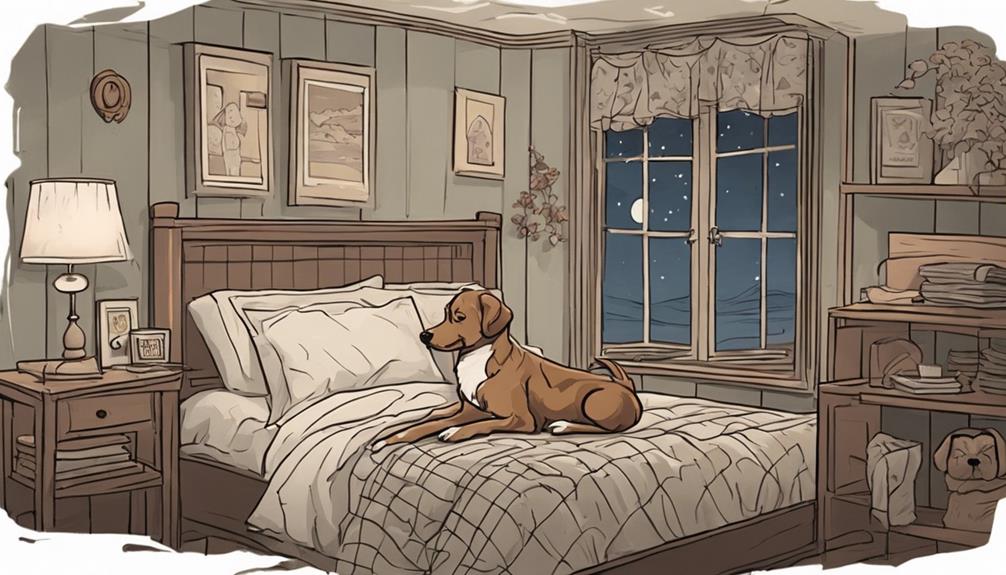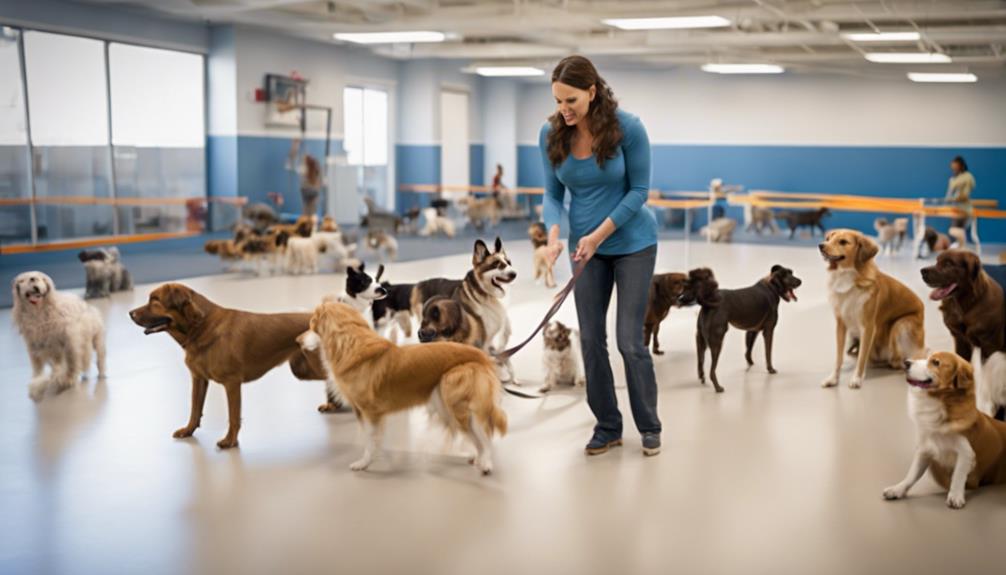To successfully train your puppy to sleep in their crate at night, begin by introducing the crate in a positive way, using treats, toys, and comfortable bedding. Encourage them to explore the crate without any pressure, and associate it with mealtime and quiet rest. Establish a bedtime routine by consistently using signals, feeding dinner a few hours before bedtime, and limiting water intake. Address any whining and barking by giving specific cues, ignoring unnecessary whining, and using counterconditioning for separation anxiety. Stick to a regular training schedule, rewarding good behavior with treats and praise.
Implement a structured nighttime potty break routine, gradually increasing intervals and rewarding successful breaks. By following these steps, you can make sure your puppy adjusts well to the crate at night.
Key Takeaways
- Set consistent bedtime routine with calming activities.
- Establish potty break schedule before bedtime.
- Use positive reinforcement for successful nighttime crate training.
- Gradually increase time between nighttime potty breaks.
- Ignore non-essential whining to discourage attention-seeking behavior.
Crate Introduction and Familiarization
When introducing the crate to your puppy, create a positive and inviting atmosphere using treats, toys, and comfortable bedding. Make the crate a place of joy by incorporating interactive toys and rewarding your puppy with treats for going inside voluntarily.
Allow your puppy to explore the crate at their own pace, without any pressure. Associate the crate with positive experiences like mealtime and quiet sleep periods to help them feel comfortable and secure. It's essential for the puppy to have their bedding in the crate, making it a cozy and familiar space.
This positive association will pave the way for successful crate training. During mealtime, you can place your puppy's food near the crate entrance and gradually move it inside, encouraging them to enter willingly. By taking the time to create a welcoming environment in the crate, your puppy will learn to see it as a safe haven and a place to relax.
Establishing a Bedtime Routine

To establish a bedtime routine for your puppy, maintain consistency in signaling that it's time to sleep. Start by feeding your puppy dinner a few hours before bedtime to allow for proper digestion. Limit water intake close to the designated curfew to prevent nighttime accidents.
Before crate time, engage in a winding-down routine to help your puppy relax. Create a bedtime signal or cue that signifies to your puppy that it's time to settle down for the night. This routine will help your puppy understand when it's time to rest, promoting a smoother nighttime crate training experience.
Managing Whining and Barking Behavior
After establishing a bedtime routine to help your puppy settle down, the next step is managing whining and barking behavior effectively. Whining and barking can be signs of various needs, such as attention or elimination. Ignoring whining that is not related to essential needs can prevent reinforcing this behavior. During crate training, use specific elimination cues to address persistent whining. If your puppy shows signs of separation anxiety through whining, consider employing counterconditioning and desensitization techniques to help them feel more comfortable being alone. Should whining and barking behaviors persist and lead to destructive tendencies, seek professional assistance promptly.
| Managing Whining and Barking Behavior | ||
|---|---|---|
| Crate Training | Elimination | Attention |
| Whining | Barking | Separation Anxiety |
| Cues | Counterconditioning | Desensitization |
| Professional Assistance |
Implementing Consistent Training Practices

Consistent training practices lay the foundation for your puppy's development and behavior. When crate training your puppy for nighttime success, it's vital to establish a routine that includes regular training sessions. By following a schedule, your puppy will learn what's expected of them at night, leading to positive habits and better behavior.
Repetition in training is key to reinforcing these expectations and helping your puppy adjust to their new home environment. Using positive reinforcement, such as treats and praise, during the training process will encourage good behavior and make the learning experience more enjoyable for your puppy.
Nighttime Potty Break Strategies
Implementing a nighttime potty break strategy is essential for ensuring your puppy's comfort and preventing accidents during the night. To help you establish a successful nighttime routine, consider the following strategies:
- Take the puppy out for a potty break right before bedtime to reduce nighttime accidents.
- Implement a consistent schedule for nighttime potty breaks to prevent accidents during the night.
- Gradually increase the time between nighttime potty breaks as the puppy gets older and can hold it longer.
Consistency is key in crate training, especially during the night. Using positive reinforcement and rewards for successful nighttime potty breaks can help reinforce good behavior. It's important to avoid giving in to demand barking for nighttime potty breaks; only take the puppy out when necessary to avoid reinforcing this behavior.
Frequently Asked Questions
What Is the Best Way to Crate Train a Puppy at Night?
To crate train your puppy at night, start with short periods in the crate, increase gradually. Use treats, praise for positive association. Set a consistent bedtime routine. Monitor behavior, adjust schedule as needed, avoid reinforcing whining or barking.
When Should I Transition My Puppy From Crate to Bed at Night?
When should you move your puppy from crate to bed at night? Consider your puppy's preparedness, behavior, and comfort level. Gradually increase time outside the crate, monitor behavior, and guarantee potty training.
How Many Nights Should I Crate Train My Puppy?
You should crate train your puppy for a duration of 8 weeks to 6 months. Consistency and monitoring are key for successful nighttime training. Adjust the schedule based on your puppy's progress and behavior to establish good habits and prevent accidents.
How Do I Get My Puppy to Stop Crying in His Crate at Night?
To stop your puppy from crying in the crate at night, provide comfort items, avoid immediate responses to whining, and gradually acclimate them to the crate. Consistent training and monitoring behavior will help address underlying issues.
What Is the Best Crate Training Schedule for Nighttime Success for Puppies?
When creating a puppy crate training schedule for nighttime success, it’s important to start by establishing a routine. Begin by feeding your puppy a few hours before bedtime and then taking them outside to eliminate. Gradually increase the time spent in the crate at night, providing comfort and reassurance.
How Can I Adjust the Puppy Crate Training Schedule for Nighttime Success if I Work during the day?
When adjusting your puppy crate training schedule for nighttime success while working during the day, try to gradually extend the time your puppy spends in their crate. Use positive reinforcement and make sure they get plenty of exercise and mental stimulation to reduce nighttime restlessness.
Conclusion
To sum up, crate training your puppy for nighttime success is like building a sturdy foundation for a house.
By following a consistent schedule, establishing a bedtime routine, and addressing any whining or barking behavior, you're setting your puppy up for success.
Remember to be patient and persistent in your training efforts, and soon enough, your puppy will be sleeping soundly through the night in their crate.
Good luck on your training journey!










